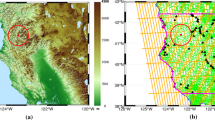Abstract
The surface bidirectional reflectance distribution function (BRDF) is an important factor in depicting the bidirectional reflectance characteristics of the land surface. In this study, BRDF is first inversed using a semiempirical, kernel-driven Algorithm for Model Bidirectional Reflectance Anisotropies of the Land Surface (Ambrals) model based on 4-day charge-coupled device (CCD) data from the HJ-1B satellite under clear sky conditions. Then, according to application needs, the inversion results of different angles are unified to the same observation angle to realize the radiometric normalization of BRDF at different viewing and incident directions. Finally, the inversed BRDF is compared with the measured BRDF in the principle plane and perpendicular plane of the Sun, respectively. The results show that: (1) The inversed BRDF based on the kernel-driven model is in good agreement with the measured BRDF. (2) The vegetation bidirectional reflectance in a backward scattering direction is higher than that in a forward scattering direction in the principle plane of the Sun. There is also a “hot spot” in the backward scattering direction. Additionally, the forward bidirectional reflectance is symmetrical relative to the backward one in the perpendicular plane of the Sun. (3) The geometric optical effect is more apparent in the visible bands of HJ-1B CCD, while the volume scattering effect is more significant in the near-infrared band. The Ambrals model and the procedures used in this study are effective and adapt to the characteristics of HJ-1B/CCD images. Therefore, our findings could advance the applications of the HJ-1 satellite and the development of quantitative remote sensing.







Similar content being viewed by others
References
Comar A, Baret F, Obein G, Simonot L, Meneveaux D, Vienot F, de Solan B (2014) ACT: a leaf BRDF model taking into account the azimuthal anisotropy of monocotyledonous leaf surface. Remote Sens Environ 143:112–121
Dickinson RE (1995) Land processes in climate models. Remote Sens Environ 51(1):27–38
Lee TY, Kaufman YJ (1986) Non- Lambertian effects on remote sensing of surface reflectance and vegetation index. IEEE Trans Geosci Remote Sens 24(5):699–708
Li XW, Strahler AH (1992) Geometrical-optical bidirectional reflectance modeling of the discrete crown vegetation canopy: effect of crown shape and mutual shadowing. IEEE Trans Geosci Remote Sens 30(2):276–292
Liu QY (2010) The atmospheric correction for visible-infrared region of HJ-1 constellation data. MSc. dissertation, Henan Polytechnic University
Liu J, Fan WY (2008) Review on BRDF model and the inversion strategy. Remote Sens Technol Appl 23(1):104–110
Liu Y, Yang Z (2001) MODIS remote sensing information processing theory and algorithm. Science Press, Beijing
Lofgren BM (1995) Surface albedo-climate feedback simulated using two-way coupling. J Clim 8(10):2543–2562
Matthew MW, Adler-Goden SM, Berk A, Felde G, Anderson GP, Gorodetzky D, Paswaters S, Shippert M (2002) Atmospheric correction of spectral imagery: evaluation of the FLAASH algorithm with AVIRIS data. Appl Imag Pattern Recogn Workshop 31(2):157–163
Rahman H, Pinty B, Verstraete MM (1993) Coupled surface-atmosphere reflectance (CSAR) model: 2. semiempirical surface model usable with NOAA advanced very high resolution radiometer data. J Geophys Res Atmos 98(D11):20791–20801
Ross J (1981) Tasks for vegetation sciences 3: the radiation regime and architecture of plant stands. Springer, Netherlands
Roujean JL, Leroy M, Deschamps PY (1992) A bidirectional reflectance model of the earth’s surface for the correction of remote sensing data. J Geophys Res 97(D18):20455–20468
Strahler AH, Muller JP, MODIS Science Team Members (1999) MODIS BRDF/Albedo product: algorithm theoretical basis document version 5.0. eospso.nasa.gov
Sun Y (2011) A study on the grassland radiative dorsiventral and directional simulation and validation. Ph.D. dissertation, Institute of Remote Sensing Applications, Chinese Academy of Sciences
Vermote EF, Tanre D, Deuze JL, Herman M, Morcette JJ (1997) Second simulation of the satellite signal in the solar spectrum, 6S: an overview. IEEE Trans Geosci Remote Sens 35(3):675–686
Wang J, Pan J, Wang L (2002) An introduction to a spatially-adaptive fast atmospheric correction for satellite remote sensing images. Remote Sens Technol Appl 17(4):193–197
Wanner W, Li XW, Strahler AH (1995) On the derivation of kernels for kernel-driven models of bidirectional reflectance. J Geophys Res Atmos 100(D10):21077–21089
Wu BY (1998) Practical algorithm for atmospheric radiative transfer. Meteorological Press, Beijing
Zhang YC, Rossow WB, Lacis AA (1995) Calculation of surface and top of atmosphere radiative fluxes from physical quantities based on ISCCP datasets: method and sensitivity to input data uncertainties. J Geophys Res Atmos 100(D1):1149–1165
Zhang H, Jiao ZT, Dong YD, Li JY, Li XW (2015a) Albedo retrieved from BRDF archetype and surface directional reflectance. J Remote Sens 19(3):355–367
Zhang H, Jiao ZT, Dong YD (2015b) Evaluation of BRDF archetypes for representing surface reflectance anisotropy using MODIS BRDF data. Remote Sens 7(6):7826–7845
Zhao YS (2003) Remote sensing application analysis theory and method. Science Press, Beijing S User Guide Version 2. 1997
Acknowledgments
We would like to acknowledge the following projects: Study on Urban Green Space Index Retrieval Model based on Airborne LiDAR, China National Natural Science Foundation. Project No. 41471310. Study on Monitoring Technique of Pearl River Delta Urban Construction Land Using in Multiple Spatial–temporal Scales with Remote Sensing. The Open Fund of Key Laboratory of Urban Land Resources Monitoring and Simulation, Ministry of Land and Resources. Project No. KF-2015-01-007. The Retrieval of Characteristic Parameters based on GF-4 Satellite Data. China National Key S and T Project of High Resolution Earth Observation System. Project No. 11-Y20A05-9001-15/16.
Author information
Authors and Affiliations
Corresponding authors
Rights and permissions
About this article
Cite this article
Meng, Q., Sun, Y., Xue, X. et al. Study on a bidirectional reflectance distribution function inversion model based on HJ-1 CCD imagery. Environ Earth Sci 75, 1288 (2016). https://doi.org/10.1007/s12665-016-6091-6
Received:
Accepted:
Published:
DOI: https://doi.org/10.1007/s12665-016-6091-6




